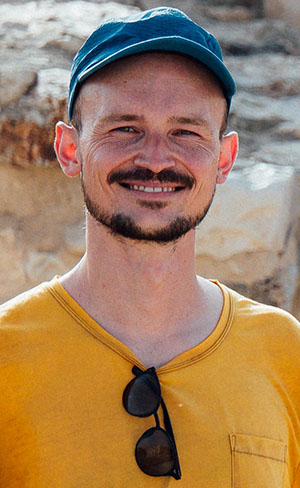About the lecture
Seals are a vital source for the study of the ancient southern Levant. Their engraved base renders them central to the study of visual culture and writing. However, seals are not only carriers of information, and there is more to seals than the imprint of their base. These tiny objects were worn as part of dress and other body adornments by ancient peoples. Taking an “embodied” perspective on the past, this lecture will outline the material, sensory, and social aspects of seal wear and use in the ancient southern Levant (2nd/1st millennium BCE). This will complicate the established notions of these objects as either jewellery or administrative devices. This presentation builds my work in gender archaeology and history, sensory archaeology, and biblical exegesis to intersect the material, sensory, and social dimensions of seals. While the archaeology of the (southern) Levant will provide the core data, this will be complemented with the iconographic and literary representations of seal wear and use in the broader ancient Near East. Thereby, the potential of seals to adorn, extend, and differentiate bodies and facilitate their appeal will become evident.
 About Dr. Biermann
About Dr. Biermann
Bruno Biermann will start a PostDoc in Hebrew Bible at the University of Münster, Germany in the fall 2024. His research bridges gender and feminist approaches to archaeology, iconography, and biblical literature. He is particularly interested in social history, the construction of bodies, and gender in the ancient world.
In his 2024 PhD thesis on stamp seals from the 2nd and 1st millennium BCE Levant as a prism for gender history, he investigated these small objects of everyday life from archaeological, iconographic, epigraphic, and exegetical perspectives. From 2020–2024, he was part of the Sinergia project “Stamp Seals from the Southern Levant: A Multi-faceted Prism for Studying Entangled Histories in an Interdisciplinary Perspective” (https://levantineseals.org).
Digital event - how to participate
The seminar will be held digitally. If you wish to attend a lecture, you need to register in advance.
A zoom link will be sent to you before the event.
You can download Zoom or use your browser: https://zoom.us/download
This lecture is part of the lecture series Ancient Adornment
Suggestions for further Reading
- Uehlinger, Christoph and Eggler, Jürg. 2022: “Seals and Sealings.” In: Encyclopedia of Material Culture in the Biblical World. A New Biblisches Reallexikon, eds. A. Berlejung, P.M. Daviau, J. Kamlah and G. Lehmann. Tübingen: Mohr Siebeck, 832–860. DOI: https://doi.org/10.1628/978-3-16-161431-6
- Biermann, Bruno. 2024: “‘Male until Proven Otherwise?’ Searching for Women with the Help of Inscribed Stamp Seals from Jerusalem”, Near Eastern Archaeology 87,1: 34–42. DOI: https://doi.org/10.1086/727577
- Biermann, Bruno. in Press. “Sensing Bodies, Touching Artefacts: Material Culture, Embodiment, and Metaphor in Song 8.6.” In: Stefan Fischer, Anette Potgieter and Gavin Fernandes (eds.), The Song of Songs: Sense, Sight, Sound and Space, Sheffield: Phoenix, 120–152. (I am happy to share this forthcoming publication: bruno.biermann@gmail.com).
- Anderson, Emily. “A Sense of Stone and Clay: The Inter-Corporeal Disposition of Minoan Glyptic.” In: Fashioned Selves: Dress and Identity in Antiquity. ed. M. Cifarelli. Oxford/Philadelphia: Oxbow, 2019, 203–218.
- Scott, Sarah J. “Beyond the Flesh. Sensing Identity Through the Body and Skin in Mesopotamian Glyptic Contexts.” In: The Routledge Handbook of the Senses in the Ancient Near East. eds. K. Neumann and A. Thomason. Oxon: Routledge, 2022, 167–188.
About the lecture series
A Digital Lecture Series on strategies of body adornment in ancient Mediterranean cultures
With this lecture series, we wish to reflect on different kinds of body adornment such as jewellery, headdresses, seals, staffs, weapons, tattoos, and cosmetics. It is our aim to investigate aesthetics and strategies of adorning bodies in ancient Mediterranean cultures, and to explore how body adornment relates to gender, hierarchy, and power.
Seven excellent international researchers, experts on the material cultures and texts of the ancient Mediterranean, will present a 30-minute lecture, followed by amble time for questions and discussion.
We are interested in mapping body adornment as broadly as possible and therefore we encourage our speakers to consider this topic from a multi-sensorial perspective and to give thought to both touch, smell, taste, hearing and vision.
Organizers
The lecture series is organized by Professor Anne Katrine de Hemmer Gudme and hosted by The Faculty of Theology at the University of Oslo and the Faculty’s research group Biblical Texts, Cultures and Receptions.
Ancient Adornment Programme - Fall 2024
- Friday September 13 at 3pm (Oslo): Dr. Uroš Matić: “Dress, Adornment and Coloniality of Gender and Desire in New Kingdom Egypt and Nubia”
- Friday September 27 at 3pm (Oslo): Dr. Sarah Hollaender: “Notorious Cross-Dressers? (Re)styling Hercules and Omphale in Roman Antiquity”
- Friday October 11 at 3pm (Oslo): Dr. Bruno Biermann: “Levantine Seals between the Material, Sensory, and the Social: Archaeological, Iconographic, and Exegetical Perspectives on Beauty, Power, and Dress”
- Friday November 1 at 3pm (Oslo): Dr. Susannah Rees: “Eye-paints in the Hebrew Bible: Looking for Meaning”
- Friday November 15 at 3pm (Oslo): Dr. Melanie Wasmuth: “Blossoms for eternity – floral jewellery in ancient Egypt”
- Friday December 6 at 3pm (Oslo): Dr. Laurence Darsigny-Trépanier and Dr. Anne Létourneau: “Bejeweled Biblical Animals: Constructing Gender with Non-Human Bling”
